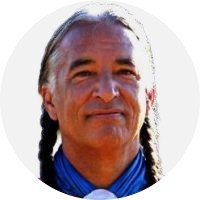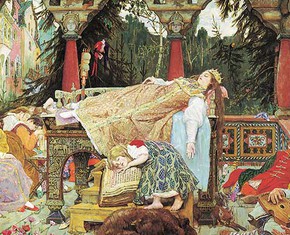The views expressed in our content reflect individual perspectives and do not represent the authoritative views of the Baha'i Faith.
In what ways does a messenger of God resemble the familiar figure of the trickster in Indigenous myth and belief? Could tricksters fulfill the same function in tribal cultures as prophets and founders of religion do in other societies?
In our continuing series on Indigenous messengers of God, we want to explore that connection a bit more. Tricksters are important figures in sacred Indigenous traditions—even though they’re utterly unfamiliar to most non-Indigenous people. Therefore the whole idea of a trickster will require some explanation, to the best of our ability.
The Encyclopedia Britannica says “Often the trickster serves as a transformer and culture hero who creates order out of chaos.” In some ways, that definition could also describe the transformative power of a holy messenger or divine prophet, as in this passage from a speech given by Abdu’l-Baha in Montreal, Canada in 1912:
God has sent forth the Prophets for the purpose of quickening the soul of man into higher and divine recognitions. … The mission of the Prophets of God has been to train the souls of humanity and free them from the thralldom of natural instincts and physical tendencies. They are like unto Gardeners, and the world of humanity is the field of Their cultivation, the wilderness and untrained jungle growth wherein They proceed to labor. They cause the crooked branches to become straightened, the fruitless trees to become fruitful, and gradually transform this great wild, uncultivated field into a beautiful orchard producing wonderful abundance and outcome.
Q: Kevin, you told me about this video: Sylvia McAdam, “Wesakechak,” about the Cree sacred lawgiver. Professor McAdam, also known as Saysewahum, has also published an important book on the subject: Nationhood Interrupted: Revitalizing Nêhiyaw Legal Systems. She is a law professor at the University of Windsor and a co-founder of the international movement Idle No More. McAdam says she “shares nêhiyaw [Cree] laws so that future generations, both nêhiyaw and non-Indigenous people, may understand and live by them to revitalize Indigenous nationhood”—although “the spiritual laws can never be written down.”
RELATED: Gluskap: Trickster, Transformer, Teacher
Wesakechak was also a “trickster,” but let’s first look at Wesakechak as a revealer of sacred laws from the Great Spirit, the Creator. In 2014, Professor McAdam released a series of “Cree Teaching Videos” on YouTube. In her “Wesakechak” video, Professor McAdam explains, in part:
This is a teaching that was told about Wesakechak. . . . Wesakechak was traveling. The Creator told Wesakechak to go to . . . the Cypress Hills in southern what is Saskatchewan now. (Wesakechak didn’t tell this story. It was the spirits that told this story about Wesakechak.) So Wesakechak made his journey from the north. . . . (If I am to tell this teaching, it would take a very long time. Because it is a very huge teaching. Everything that I speak about here — it would take a long time. These are the very short versions of these teachings.)
So Wesakechak made his way. And along the way, there was animals that joined him. And he made stops along the way. Those stops along the way are very sacred places now for the Cree people. The most significant of those places are Cypress Hills. So Wesakechak went there. . . . He arrived at Cypress Hills. And the Creator told him: “Go to the highest hill. And when you will go, when you get to the highest hill, I want you to sing four songs.”
He made his way to the highest hill. And when he got to the highest hill, he sang the four songs to the four directions. And he turned to the four directions and he sang those four songs. And one of those songs is a woman’s song. And when he was done, after he was done singing, it was then the Creator gave him the laws of the Cree people and the Saulteaux [pronounced “Soto”] people. … When he gave the laws to Wesakechak, the Creator told him: “Give these to the people to follow for all time.”
And he came down that hill. And he took those laws to the people. And the people are to follow these laws for all time. And it is from there he traveled. He traveled all of the lands. And he told the people: “These are the laws that the Creator gave us that we must follow.” . . .
These are all very, very profound laws. And they are not human-created. . . . So these laws are to guide and govern Indigenous people in everything that they do. This is how come our connection to the Creator was so sacred, so powerful because of these laws. – Sylvia McAdam, “Wesakechak” (Aug. 20, 2014).
In light of Professor McAdam’s above comments, it’s obvious that Wesakechak is an important and key figure in Cree sacred tradition. Kevin, do you have any further comment on this?
A: Professor McAdam focuses on Wesakechak as a lawgiver and culture hero only. Have you found any videos in which she elaborates on the alleged trickster dimension?
Q: I just watched “Cree Cultural Teachings by Sylvia McAdam,” but didn’t find any mention of Wesakechak as a transformer/trickster figure in that excellent lecture.
There are other videos, of course. See, for instance, this animated video: “The Legend of Weesakayjack – First Nation Legend – How North America came to be – Canada;” or this one: “The Trickster – A Tale of Wesakechak.” Kevin, would you like to comment on these trickster stories?
A: The first video is interesting to me because of the many times I’ve heard this legend. But this is the first time that the telling has involved other than Sky Woman. That said, it is such a superficial telling of the legend with words so badly mispronounced that I question the source.
The second video focuses solely on the trickster side, but omits the important discussion of life lessons expressed in the story. Importantly, these stories were told not just for entertainment, but to give key lessons for physical and social survival.
Q: Excellent comment. An example of a trickster in the Abrahamic traditions is the mysterious and enigmatic figure of al-Khidr, who teaches Moses, as told in the Qur’an (18:65–82), the sacred book of Islam. Many Indigenous traditions place a great value on storytelling. Stories of various tricksters serve, with children and youth especially, to teach serious moral lessons about human frailties and shortcomings. Are some of the Trickster traditions comparable to Aesop’s fables, in that there is a moral to each story?
A: Yes, the trickster is just one of a wide cast of characters that feature prominently in Aesop-like tales that abound in Indigenous North America. For example—the “Brer Rabbit” stories are adapted from the long pre-existing southeastern narrative tradition in which the rabbit is the main trickster. The Lakota have a very comparable story to the tale of Brer Rabbit being thrown into the briar patch. The famous “Wile E. Coyote and Road Runner” cartoons were inspired by the southwestern trickster, Coyote. These pop culture appropriations lack the in-depth character development and moral teachings of the originals, though.
RELATED: Why Baha’is Respect Indigenous Sacred Traditions
Q: So it seems to me that Wesakechak is an Indigenous messenger of God because, according to Professor McAdam, he was a spiritual teacher and a lawgiver. At the same time, he is also a trickster and transformer. Although the two traditions appear to be contradictory to a non-Indigenous observer like myself, both roles of Wesakechak, as lawgiver and trickster, have wisdom and moral teachings in common. Would you like to comment further, Kevin?
A: I suspect that this dilemma will remain unresolved until we can find an eminent scholar, like Professor Sylvia McAdam, who can decipher the puzzle. The Lakota have the same story as shared above. But our trickster, Iktomi, is never confused with a divine messenger.
Q: As for Wesakechak and the Cree laws he brought, Sylvia McAdam wrote: “in the spirit and intent of Indigenous sovereignty and treaty … non-Indigenous people must begin supporting and encouraging Indigenous laws and teachings, in every aspect, and by whatever means possible.” In our Indigenous messengers of God series here at BahaiTeachings.org, we have tried to convey some of this sacred knowledge through relying primarily on published, respected Indigenous sources, with advance permission, and with the following principles in mind, as outlined in this statement on the rights of Indigenous populations from the Baha’i International Community:
Appreciation for diverse cultures and ethnic characteristics is, in the Baha’i view, a prerequisite for the elimination of discrimination against indigenous populations. We are convinced, therefore, that a declaration should call for educational measures that seek to foster an awareness of, and appreciation for, cultural diversity. All people—Indigenous peoples as well as members of other cultures—should have the opportunity to benefit from mind-broadening educational programmes designed to increase understanding between indigenous peoples and the dominant society, as well as between different groups of the indigenous peoples themselves.
A: Chris, our rich Indigenous cultures and traditions have so much to teach everyone, regardless of their background, ethnicity, or heritage.
You May Also Like
Comments


















Knowing that these tales are being filtered through several layers of European thought, ...it is instructive to read this famous poem and find many hidden threads of a spiritual teaching throughout.
I think the essence of these tales will be hard to get at until each culture has a better chance to delve deep into the revitalization of their language and their culture.
Dave Lea